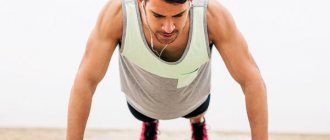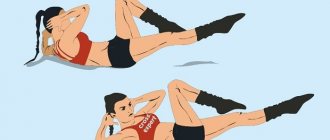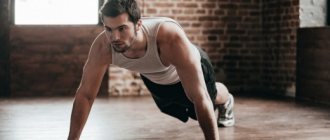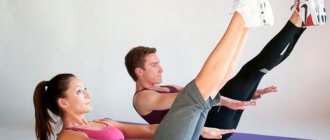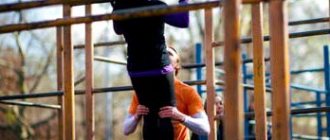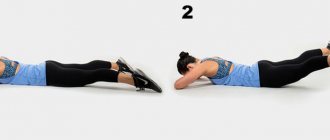How to learn to do 100 push-ups? The most effective 6-week program will help you!
Regardless of your fitness level and current rep count, this program is guaranteed to increase your push-up count by at least 100 times in 6 weeks.
Correct performance of push-ups
Before starting the program, you need to determine your fitness level by doing the maximum number of push-ups. If you have done more than 20 push-ups, you can start not from the first week, but from the appropriate amount based on your results in weeks 3 or 5.
If your level is 6-7, then you need this more complex program.
You have determined your level of preparation, now go ahead! Based on the results, select the desired column and perform the specified number of repetitions. You need to train 3 times a week Monday/Wednesday/Friday or Tuesday/Thursday/Saturday .
How to start classes correctly
When starting to do push-ups, it is important not to overdo it. Don't overwork yourself on the first day.
It is important to perform push-ups correctly, only in this case the exercises will give significant results.
Basic mistakes when performing push-ups:
- Elbows too far apart. This is fraught with injury. Keep your elbows turned 45 degrees back.
- Lack of warm-up before training.
- Incomplete amplitude.
- Body deflection.
- Lifting the pelvis up.
- Incorrect breathing.
A proper push-up looks like this:
You can see the correct execution in the video.
Breathing is equally important when doing push-ups. Its frequency affects blood pressure, and therefore correct breathing is one of the fundamental factors. The rise should occur as you exhale; as you inhale, the body lowers.
In addition, proper motivation is important. One of the main requirements is consistency of execution; without it you should not expect a good result.
There are various push-up programs, following which you can achieve good results.
The most famous programs:
- 15 Week Push Up Program;
- 20-week push-up routine;
- “100 push-ups” program.
Advice from professionals
To form a holistic understanding of the benefits of regularly performing push-ups, beginners should familiarize themselves with the opinions of professionals on the issue at hand.
Alina is sure that every person who cares about their own health should be able to do push-ups. By devoting just 5-7 minutes daily to multidirectional push-ups, an athlete can fully work out the muscles of the arms, shoulders, back, neck and even abdomen, and also increase the overall endurance of the body.
Maxim includes in his training program complicated variations of push-ups, for example, with fists, with clap, or on one hand. It is thanks to such loads that his body becomes sculpted, resilient and strong before competitions.
What's stopping you from continuing?
Not everyone can complete the entire challenge of doing push-ups every day for a month. It often happens that doing exercises is postponed until later. As a result, the amount of exercise performed per day decreases. Motivation disappears; it is difficult for a person to force himself.
Here are some reasons why it is difficult to complete a test.
- Muscles hurt. If a person has practically never done sports before, then the muscles will get used to it for quite a long time.
- It will be much more difficult to force yourself to work in the evening than in the morning.
- The feeling of satisfaction that you are coping with the task will not come immediately. For about a few weeks, you will have to make an effort to force yourself to study.
Basic rules for the final stages
To achieve the desired result, you should follow a few simple rules after completing your workout:
During exercise, muscles produce lactic acid and shorten. To avoid postural distortions, get rid of pain after training and visually improve muscle relief, it is recommended to stretch after each session, especially those muscle groups that received the predominant load. Massage will help relax your muscles - you can even do it yourself
Close attention should be paid to the shoulders, shoulder girdles and shoulder joints. Half a minute of massage will be enough. It doesn't hurt to take a warm (but not hot) shower or bath with aromatic oils - this will help relieve stress.
After training, it is undesirable to go outside in cold and windy weather - the risk of getting sick increases, since a sharp change in temperature negatively affects the body, which is hot after exercise.
Push-ups are a variable exercise, and everyone can choose a suitable program for themselves. The main thing is not to stop believing in yourself and strive for new achievements!
Types of push-ups
If the “100 push-ups” program has been successfully completed, but you have no desire to quit, you have the opportunity to try other types of push-ups. This exercise has a large number of different variations.
Classic
A well-known type of push-up. This is what students do in schools.
Positioning of hands during classic push-ups: positioning of hands wider than shoulder level. Focus on your toes and palms.
As mentioned above, proper push-ups are the key to your success. Don't forget that there should be no arching in your back.
Knee push-ups
This type of exercise reduces the load on all muscle groups. This is an ideal option for beginners.
The starting position coincides with the position in classic push-ups, with the caveat that these push-ups are done with emphasis on the knees.
From a horizontal surface and from a wall
If you feel that your training is not enough even for push-ups from your knees, then wall push-ups are ideal for you.
The technique is simple. Starting position: facing the wall, hands positioned slightly wider than shoulder level. It is preferable to rest not on the entire foot, but solely on the toes. This will allow you to get the maximum benefit from the exercise.
Push-ups from a horizontal surface are quite difficult, especially when compared to push-ups from a wall. The surface can be either the floor or the bench.
Wide grip
Wide-grip push-ups put the main load on the pectoral muscles. If your goal is to pump up your chest, then you should focus on this type of push-ups.
Wide-grip push-ups are of medium difficulty level. They are not suitable for beginners.
When starting to do push-ups, you need to place your hands at a distance greater than shoulder level. The palms can be directed both forward and to the side. It is acceptable and even desirable to spread your elbows wide.
With a medium grip
This type of push-up puts most of the load on the triceps and deltoids.
Palms are located at shoulder level. The legs should be less than shoulder width apart from each other.
You can place your legs on an elevation - this will increase the load. However, if you want to reduce the load on the contrary, you should place your hands on a raised platform.
Narrow grip
When doing push-ups with a narrow grip, the main load is on the triceps muscle, as well as on the chest and deltoids. This movement is similar to the close grip bench press in terms of stress on the muscles.
You need to place your hands so that your thumbs and index fingers touch each other. Place your elbows as close to your sides as possible.
On one hand
One-arm push-ups develop the triceps muscles and forearms.
To perform this type of exercise, you need to have quite a lot of experience in sports, since push-ups on one arm are considered one of the most difficult.
The starting position differs from the classic version in the width of the legs. After taking the starting position, lift one hand off the floor and place it behind your back.
If you are trying this type of push-up for the first time, it is not a fact that you will achieve the full amplitude right away. To begin with, doing the exercise at full strength is not at all necessary.
With clap
Clapping push-ups use the same muscles as regular exercises.
The peculiarity of this type is that during the lifting process you make a sharp push and throw your body up. If other types of push-ups are used mainly as relief training, then these push-ups will help develop dexterity.
This exercise also requires preparation and experience. The danger of doing push-ups with clap is that you may not have time to clap and fall. To avoid this, you should first practice without clapping, simply lifting your body up.
On fingers
Finger push-ups are a fairly effective and unusual exercise.
When performing this type of push-ups, endurance increases, a huge number of very diverse muscle groups work:
- chest muscles;
- triceps muscles;
- forearms;
- back muscles;
- trapezius muscle;
- deltas;
- press;
- buttocks;
- calf muscles;
- hips.
These push-ups are a great way to prevent arthritis.
Hand position in this exercise is not a fundamental factor. Place your hands with a wide or narrow grip at your discretion.
Video about how to properly perform push-ups on your fingers.
If push-ups using your fingers are difficult, consider push-ups using your fists. Here the emphasis is not on the palms, but on the knuckles, turned perpendicular to the body.
With weights
Weighted push-ups are aimed at developing the pectoral, deltoid and triceps muscles. However, this exercise also works other muscles:
- press;
- leg muscles;
- intercostal muscles;
- back muscles.
Additional weights when doing push-ups are used to get a greater effect from training.
If you constantly train only with your own weight, then over time the effectiveness of your training will begin to fall. This occurs due to the body’s adaptation to the load, so over time it is better to increase the load, but gradually.
Typically, push-ups are done to gain muscle mass. Dumbbell push-ups are also suitable for greater muscle development. In addition to other muscles, they involve stabilizer muscles. A little more about this exercise.
Deep push-ups
If regular push-ups have begun to seem too simple to you, and you want to increase your range of motion, then deep push-ups will be an ideal option. Thanks to special supports for push-ups, you have the opportunity to make the exercise more difficult and increase the amplitude. However, you will not be able to gain muscle mass through such exercises.
Do not forget that the amplitude should be increased gradually. Otherwise, there is a risk of muscle strain or injury.
Third week of training
So, you are stronger than you were at the beginning of the journey, and the test you took at the end of the second week objectively shows this.
Remember his results?
- If you did 16-20 push-ups in your last test, the first column in the table below is yours.
- 20-25 push-ups - second column.
- More than 25 push-ups? Cool! Third column.
It may happen that for some reason you did not become “stronger” and did less than 16 push-ups. The reasons may be different, but you should not despair. Just repeat “week two” again. You will succeed!
Table . Third week of training
Fourth week of training
Practice in the same “column” as in the third week. At the end of the week you will have another endurance test. As usual, you will need to remember the test data, your fifth training week will depend on it.
Table. Fourth week of training
What helps you endure
If you overcome laziness, hold out, and do the exercises every day for a month, you will really like the result. But sometimes it’s very difficult to hold out.
Some tricks can help with this.
- Give yourself small rewards for each approach.
- Set a reminder on your phone. When the signal rings, do not delay the exercise.
- Don't put off doing the exercise, even if you are at work.
- Post photos and videos on social networks about how you perform the exercises and what results you achieved. This will motivate you and your friends.
